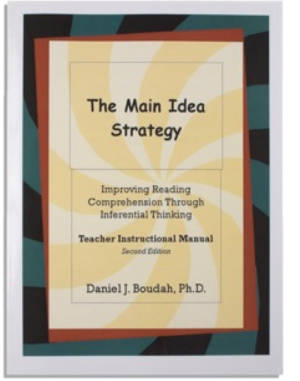The Main Idea Strategy

Many middle- and high-school students have difficulty understanding what they read. Perhaps more importantly, many students have a particularly hard time finding main ideas when they have to “read between the lines” to infer the main ideas. This appears to be true for students with and without disabilities and across different disciplines in which they have to read for meaning. Difficulty with inferring main ideas also impacts student performance on state reading tests, in turn, affecting districts’ measures of Adequate Yearly Progress (AYP) in conjunction with No Child Left Behind regulations.
The Main Idea Strategy is a strategy designed improve the performance of students with learning disabilities and other students who perform poorly on reading comprehension tasks requiring them to comprehend inferential main ideas. The Main Idea Strategy consists of five steps focused on identifying the details of a passage, determining how they are related, and inferring the main idea. The steps are easily remembered with the first-letter mnemonic device “MAIN-I.” Teachers teach the strategy to students following an instructional sequence divided into four parts. Most students substantially improve their performance determining main ideas in many types of reading materials and state tests.
Author(s):Daniel Boudah
Publication Info: Edge Enterprises, 2012
Resources:
The Story Behind the Main Idea Strategy
The Main Idea Strategy emerged from my experiences, first, as an English/Language Arts teacher. I became aware that many students in middle and high school could not understand what they read. Unfortunately, this is still true, and perhaps more importantly, many students have a particularly hard time finding main ideas when they have to “read between the lines” to infer the main ideas. This appears to be true for students with and without disabilities, and across different disciplines in which they have to read for meaning.
Therefore, given the context of student needs and demands, as well as the proven success of some existing learning strategy programs, the Main Idea Strategy was researched and developed based on several important points. First, previously developed strategies to enable low performing students to read and understand main ideas may be insufficient because they are often limited to finding literal, rather than inferential, main ideas. Second, most secondary school reading requires that students infer meaning from poorly organized and written textbooks. Third, high or even acceptable student performance on state reading tests depends on students’ success at determining inferential main ideas, affecting districts’ measures of Adequate Yearly Progress (AYP) in conjunction with No Child Left Behind regulations.
Teacher and Student Feedback on the Main Idea Strategy
I trust that you will find success using the Main Idea Strategy, as have many teachers and students already. Perhaps this student has expressed the value of the strategy best: “The strategy helped me improve my science grade a lot! Without even knowing that I was using it, when I was taking notes and stuff, then I was!”
This product is available through Edge Enterprises, Inc.
Please note that professional development, coaching, and infrastructure support are essential components to effective implementation of SIM instructional tools and interventions. It is highly recommended that you work with a SIM professional developer. See the SIM Event list for sessions or email simpd@ku.edu to learn more.
An accessible version of the documents on this site will be made available upon request. Please contact the KU CRL Professional Development Research Institute, at simpd@ku.edu to request the document be made available in an accessible format.